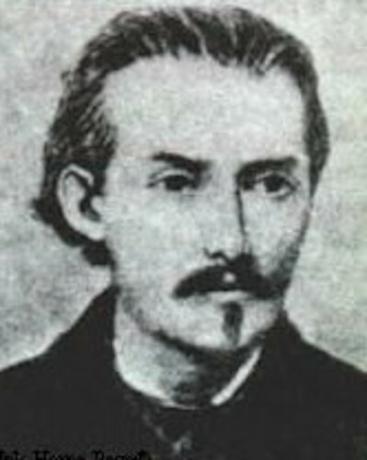Casimiro de Abreu was born on January 4, 1839, in Barra de São João, in the Rio de Janeiro. O poet he was raised on his mother's farm, but in 1852 he moved to the city of Rio de Janeiro, at his father's request, to work in commerce, having only completed primary school. The following year, he traveled with his father to Portugal, where he wrote much of his work. In 1859, already back in Brazil, published his book of poetry the springs.
Belongs to second generation of Brazilian romanticism, the poet wrote a nostalgic and bucolic poetry, marked by simplicity and spontaneity, in which he highlighted his patriotism, the loving idealization and the feeling of death. Like other writers of his time, he also contracted tuberculosis, the disease responsible for his death, at just 21 years of age, on October 18, 1860.
Read too: Castro Alves – abolitionist poet of the third generation of romanticism
Biography of Casimiro de Abreu

Casimiro de Abreu was born on January 4, 1839, in Barra de São João
, in the state of Rio de Janeiro. He was the son of Portuguese merchant José Joaquim Marques and Luísa Joaquina das Neves. However, his parents never lived together. Therefore, he was what, at that time, was called a “natural son”, a very complicated situation if analyzed by the moral values of the time.As a child, he lived on the Fazenda da Prata, property inherited from his mother's first husband, who was a widow. The poet had only primary education and, between 1849 and 1852, studied atFreese Institute (Nova Friburgo), where he met his great friend, the writer Pedro Luiz Pereira de Souza (1839-1884). So, in 1852, without completing the Humanities course at Freese, he went to live in the city of Rio de Janeiro, where, by his father's wishes, he worked in a warehouse owned by a friend of José Joaquim.
Next year, he traveled with his father to Portugal, where he began his writing career and produced most of his work. your theater play Camões and Jau was staged at theater D. Fernando in 1856, with success. In that country, Casimiro de Abreu also wrote for the newspaper Luso-Brazilian Illustration. However, he returned to Brazil in 1857, when he wrote for the periodicals the groundhog, The mirror, Popular Magazine and Mercantile Mail, in which he met the writers Manuel Antônio de Almeida (1830-1861) and Machado de Assis (1839-1908).
He published his book of poetry — the springs — in 1859, a publication funded by his father. However, Casimiro de Abreu, like other writers of his time, contracted tuberculosis and he ended up dying on the farm in Indaiaçu, owned by his father, who had died six months earlier. So, with just 21 years, the poet died in October 18, 1860.
Do not stop now... There's more after the advertising ;)
Literary Characteristics of Casimiro de Abreu
Casimiro de Abreu is a writer linked to second generation romantic, or ultraromanticism, which features the following features:
- Escapism
- Pessimism
- nostalgia
- self-centeredness
- Morbidity
- loving suffering
- sentimental exaggeration
- Idealization of woman and love
- Feeling of boredom and melancholy
- horrendous locus: description of "stormy place"
In addition poetry of the author presents the following thematic:
- Nostalgia
- bucolicism
- religiosity
- Foreboding of death
- Patriotism
- praise of youth
Your poems are marked by:
- Simplicity
- regular verses
- Spontaneity
- sentimentality
- Melancholy
Read too: José de Alencar – main author of romantic novels in Brazil
Works by Casimiro de Abreu
![Cover of the book “Primaveras” (or “As Primaveras”), by Casimiro de Abreu, published by L&PM.[1]](/f/cedd8d17560c290701861f583b301aa8.jpg)
-
Poetry
- the springs (1859)
-
Prose
- Carolina (1856)
- Camila: memories of a virgin (1856)
-
theater
- Camões and Jau (1856)
O most famous poem by Casimiro de Abreu is “My eight years”, from the book the springs. In this poem, the me lyric, with nostalgia, idealization and melancholy, speaks of his childhood, as you can see in the following excerpts:
Oh! what miss you I have
From the dawn of my life,
Of mine childhood Honey
That the years bring no more!
What love, what dreams, what flowers,
in those smoky afternoons
In the shade of the banana trees,
Under the orange groves!
how beautiful the days are
From the dawn of existence!
— Breathe the soul innocence
Like flower perfumes;
The sea is — a serene lake,
The sky — a bluish mantle,
The world — a golden dream,
Life—a hymn of love!
What auroras, what a sun, what a life,
what melody nights
in that sweet joy,
In that naive play!
The embroidered sky of stars,
The land of scents full,
the waves kissing the sand
And the moon kissing the sea!
Oh! days of my childhood!
Oh! my spring sky!
How sweet was life
On this smiling morning!
Instead of the hurts of now,
I had these delights
from my mother the caresses
And kisses from my sister!
[...]
Like features of the romanticism and poetry of Casimiro de Abreu, it is possible to point out:
- escapism in memories
- nostalgia
- egocentrism (theme centered on the lyrical self)
- bucolicism (idealization of nature)
- simplicity
- regular verses (rounds bigger)
Image credit
[1] L&PM Editors (reproduction)
by Warley Souza
Literature teacher
